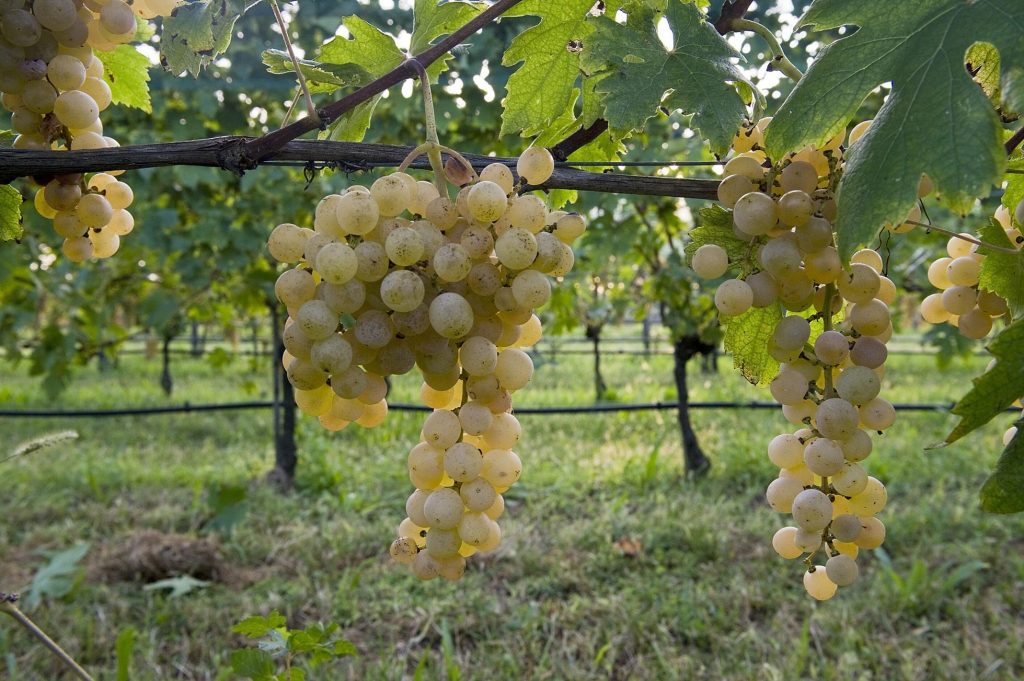Venice’s And Dorona’s Golden Wine Age
Though Venice’s role as wine broker largely ended with Napoleon, its identity as a wine-growing place never vanished. During centuries of dominance as a maritime power importing barrels from Crete, Cyprus, Dalmatia, and beyond, Venice also grew grapevines in cloistered monasteries, lagoon island patches, and family gardens. The most common varieties? Malvasia and Dorona di Venezia.
You see the vine cultivation in the names across the lagoon: the island of Vignole (”vineyard island”), San Francesco Della Vigna (”Saint Francis of the vine”), even San Francesco del Deserto, which used to be Isola delle Due Vigne (”Island of the Two Vineyards”).
Viticulture has always been present in Venice.
While Malvasia spread across the Mediterranean, Dorona di Venezia remained uniquely Venetian, as it was the most widely planted grape in the Venetian islands and a favorite of the doges and nobility.
Dorona’s thick skins were able to withstand the briny soils and salty winds of the lagoon and islands, and it tastes like its terroir—honeyed yet saline, with a depth unusual for a white. It survived in the lagoon for centuries, but when the catastrophic Acqua Grande flood of 1966 drowned the vines, Dorona was declared extinct.
That was until 2002, when Gianluca Bisol, of the 500-year prosecco wine dynasty Bisol 1542, stumbled upon a handful of Dorona vines in a private garden of the seventh-century basilica of Santa Maria Assunta on the nearby island of Torcello: the Dorona di Venezia, a variety specific to the lagoon and extremely rare. His discovery was less a vineyard and more gnarled stems surviving against odds. Just eighty-eight vines were still clinging to life.
Bisol chose to bring them to the heart of the lagoon: the ruined monastery estate of Scarpa Volo on Mazzorbo island, connected to Burano Island by a footbridge. Against every warning about saline soils and flooding risk, he planted nearly a hectare of Dorona inside the medieval walls and called the place and the wine Venissa.
In 2010, the first harvest arrived, and with it a few thousand bottles adorned with a square of gold leaf fused into Murano glass—a nod to Venice’s trinity of wine, gold, and glass—inspired by the grape’s name itself, Dorona (“golden”).
Today, Dorona thrives inside those monastery walls surrounded by lagoon. The flagship wine, Venissa Bianco, is unlike most whites. Made with prolonged skin contact, it shines amber-gold, textural and tannic like a red, savory and saline with a lingering finish.
Its counterpart, Venusa Bianco, comes from Dorona grown at a very slightly higher altitude — making distance to the sea below farther away. Venusa expresses a brighter side—wildflowers, yellow fruit, and mouth-watering freshness.
The difference in wines is notable. The entire vineyard looks flat, but small altitude differences matter in a place where the topsoil lies just 1.2 meters above the lagoon waters.
Dorona may be Venice’s most dramatic viticultural story, but it is not the only one. In 2019, Santa Margherita began tending Venice’s oldest urban vineyard, hidden in the cloisters of San Francesco della Vigna, the oldest urban Venetian vineyard.
Documented since 1253, the vineyard was replanted in 2019 with Glera and Malvasia. Farmed by hand by the church’s Franciscan friars, the site now yields about 1,000 bottles per vintage of Harmonia Mundi, a limited edition Charmat-method sparkling wine in blue-and-gold screen-printed bottles that pay homage to the reflections of Venice’s canals.
Unlike Venissa, whose wine is available for purchase, Harmonia Mundi’s distribution is limited to the city’s most exclusive hotels. Its proceeds fund students at the Institute of Ecumenical Studies in the complex and the restoration of the Chapel of San Marco.
On the island of Vignole, the IsolaLeVignole project recently planted two hectares of Dorona to complement the resurrection of Trattoria de Vignole, reopened in 2024 with event spaces, organic gardens and the vineyard which produces wine for onsite tastings.
Together, these projects suggest a quiet revival of Venice’s wine culture. Dorona certainly represents resilience, reborn from near extinction into a wine that channels both heritage and terroir. Harmonia Mundi brings back the tradition of cloistered urban viticulture, reframed with modern craftsmanship.
For visitors, this reframing reveals a Venice beyond gondolas and palazzi: a living agricultural landscape where vines still push through saline soils as they have for centuries.
For the wider wine world, Dorona is proof that heritage grapes can be rescued and made newly relevant—even in the most unlikely of places—to reframe a region’s cultural past.
As Carnevali explains, “Venissa comes from Venetian dialect, variations of the word ‘Venezia.’ Both Venissa and Venusa mean Venice—it’s about the soul of this place.”
Venice’s Dorona story and the renaissance of lagoon wine are part of a larger Italian movement to reclaim lost grapes and reimagine vineyard spaces. Across the country, ancient varieties are being coaxed back into life in urban plots: in Rome, the Bellone grape, which traces back to the Roman Empire, has been replanted on the Palatine Hill, just steps from the Colosseum, while Turin, Milan, Florence, and Naples all tend historic city vineyards.
Italy now leads the world with more than 30 urban vineyards across 15 cities, the highest in the world. Together, they show how heritage varieties like Dorona, once nearly forgotten, can root again in unlikely soils—reviving not just vines, but the cultural memory of wine itself.

